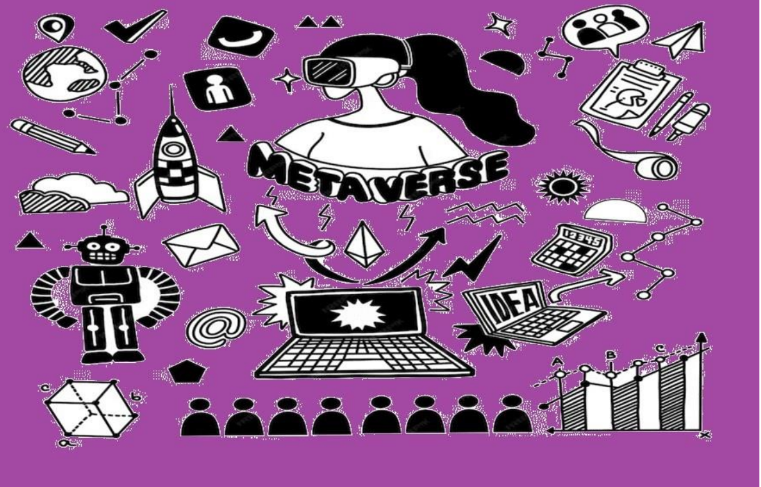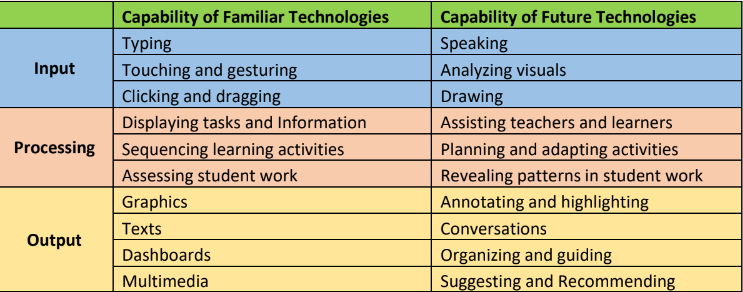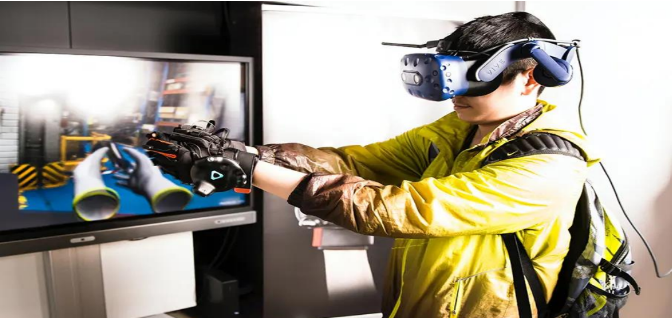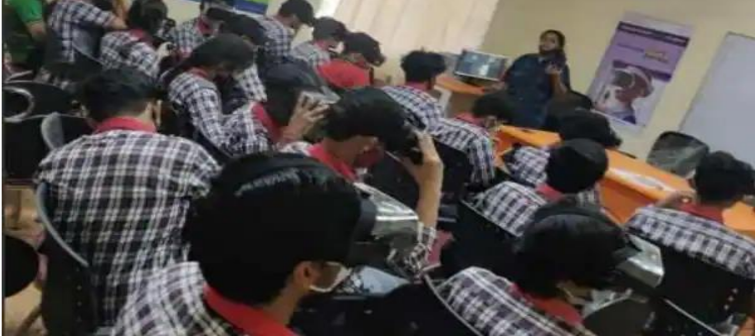 Illustration 1: This doodle art represents the various forms of futuristic technologies and how they could be incorporated into education. Source: freepik.com 1
Illustration 1: This doodle art represents the various forms of futuristic technologies and how they could be incorporated into education. Source: freepik.com 1
Close your eyes and imagine the giant Jupiter in front of you while you are learning about planets in the classroom. Or when you look up to the ceiling of your classroom you can witness the entire Milky Way galaxy, and all of your classmates are amazed by the sight. You must be questioning about the possibility of all this happening. However, all of this was made possible in a school in Malappuram, Kerala 2 . The school used Augmented Reality to bring the existence of the things to the classroom, that students were learning about. This is a prototype case of the amalgamation of futuristic technologies with education where we are transcending the boundaries of space and time.
Experts in the field of these technologies are trying to bring them into the field of education and helping revolutionize the landscape of education. A team of researchers from IIT Madras was preparing an experiential learning environment using AR/VR for rural schools 3. Through gamification, digital storytelling, and virtual reality, students can learn the concepts of science, social science, and languages. The project aims to enable students to have mobility and access through portable platforms and bridge the digital divide between rural and urban schools. Many such projects have been running all across the globe to understand to what extent can technology be integrated
into education and its impact on improving the learning of learners. These also help to understand how technology could serve as a tool to overcome the socioeconomic barriers that affect learning.
Illustration 2: Students in Kohima, Nagaland, experiencing learning simulations through VR sets. Source: livemint.com 4.
Futuristic Technologies v/s Current Technologies
Currently, technology has shifted education to a step ahead. With the help of familiar technology, students can now use multimedia to learn about different concepts, they can access materials at any point in time while sitting in any geographical location, and learn about the concepts in the form of games which makes learning more engaging and immersive. However, futuristic technologies have the potential to take education to a whole new dimension. It has the potential to make learning more interactive where students along with learning the concepts, can also organize and analyze them, and design their learning models and projects. Futuristic technologies would be more advanced than the current technologies in terms of their input, processing, and output performance. In terms of input, they would enable teachers and students to speak and ask about the concepts and analyze and draw the visuals. It would not be just restricted to clicking, touching, and typing. In terms of processing, they would help teachers and students to plan and adapt teaching-learning activities according to the pace and level of understanding. With futuristic technologies, teachers would not only be restricted to assessment but also to identify
emerging patterns in students’ work. Based on the output, these technologies would help them to hold conversations with the software instead of just relying on interpreting the text and organizing tasks. They would also provide recommendations on reliable and effective resources that could be used by learners and teachers.

Table 1 shows the difference between familiar technologies and future technologies in the context of education, in terms of input, processing, and output. Source: Artificial Intelligence and the Future of Teaching and Learning 5
An Experience that is Immersive
 Illustration 3: A learner experiencing using a mechanical part with the help of Haptic technology. Source: education.illinois.edu 6.
Illustration 3: A learner experiencing using a mechanical part with the help of Haptic technology. Source: education.illinois.edu 6.
Today many emergent technologies are being used in different fields like aviation and space, simulators, automobiles, robotics, and so on. Experts in these fields experiment and incorporate these technologies into these areas to make the services more efficient, advanced, and according to the needs of the individuals who avail the services. However, there is a vast scope to explore how these technologies can be incorporated into the realm of education to make learning more immersive.
The emerging field of haptics or haptic sensing is based on the ability to perceive objects through touch. Our sensory receptors give us feedback based on the vibrations or movements we receive from the outside world. This feedback mechanism helps us to make sense of the world. According to Jones (2018) there are two important elements of haptics: touch and kinesthesia 7. Kinesthesia is the ability to locate the position of limbs and sense their movement.
In education, the technology of haptic sensing can be incorporated to help students understand different concepts through touch and kinesthesia. This technology is prevalent in industry, engineering, and medical domains. However, haptic tools in the educational field need to be explored and built. In the future, with the help of simulators, students will be able to feel the scales on the body of a snake, perceive how magnetic force works, and does it feels to be in space. Haptic sensing has the potential to help students perceive those things and events that are otherwise difficult to experience in daily life.
A New Form of Collaboration
Today we are living in a knowledge society that is driven by information, technology, and communication. If knowledge is the spacecraft, then ICT has become the propellant that is required to construct, process, and disseminate the knowledge. To make effective use of this propellant, it is required that students learn some skills that are required in the twenty-first century.
One of those skills is Collaboration. The skill of collaboration is about building relationships and working together to achieve a common goal. The current National Education Policy8 also talks about the integration of skills of collaboration and teamwork in the curriculum. After the emergence of the internet, our society has become interconnected in terms of sharing and exchanging ideas, creation of knowledge, teaching, and learning. Hence technology makes it possible to connect with people across different geographical locations and cultures and collaborate for projects, experimentation, exchange of knowledge, and learning new concepts and skills. With futuristic technology, we are witnessing a new form of collaboration between humans and artificial intelligence. Futuristic technologies help to aid natural intelligence with the help of assistive intelligence and automation AI. In the educational context, these futuristic tools would be used to design some conceptual models and visual representations that would help to enhance the learning of the learners.
What’s the Future
Futuristic technologies in the domain of learning and education are still unexplored. Different emerging technological tools could be incorporated in such a way that they facilitate the pedagogy, learning process, and development of twenty-first-century skills among learners.
References
1. https://www.freepik.com/premium-vector/metaverse-virtual-reality-concept-doodle-style-outline_30756304.htm
2. https://youtu.be/05mWltJ1M8Q?feature=shared.
3. IIT Madras researchers developing AR/VR-based education model for rural schools. (2023, April 12). Business Line. https://www.thehindubusinessline.com/news/education/iit-madras-researchers-developing-arvr-based-education-model-for-rural-
schools/article66728891.ece
4. Choudhury, M. D. (2022, February 25). Virtual reality headsets enter computer labs in Indian schools. Mint. https://www.livemint.com/technology/tech-news/virtual-reality-headsets-enter-computer-labs-in-indian-schools-colleges-
11645766029704.html
5. Office of Educational Technology. (2023). Artificial Intelligence and the Future of Teaching and Learning. https://www2.ed.gov/documents/ai-report/ai-report.pdf
6. University of Illinois Urbana-Champaign. (2023, February 27). Haptic Technology Offers Powerful Tools in a New Era of Exploratory Learning. https://education.illinois.edu/about/news-events/news/article/2023/02/27/haptic-technology-offers-powerful-
tools-in-a-new-era-of-exploratory-learning
7. Jones, L. A. (2018). Haptics. Massachusetts Institute of Technology.
8. Government of India. (2020). National Education Policy. https://www.education.gov.in/sites/upload_files/mhrd/files/NEP_Final_E




Recent Comments